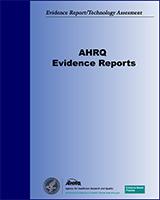NCBI Bookshelf. A service of the National Library of Medicine, National Institutes of Health.
This publication is provided for historical reference only and the information may be out of date.
Structured Abstract
Objectives:
Systematic review of outcomes of three treatments for osteoarthritis (OA) of the knee: intra-articular viscosupplementation; oral glucosamine, chondroitin or the combination; and arthroscopic lavage or debridement.
Data Sources:
We abstracted data from: 42 randomized, controlled trials (RCTs) of viscosupplementation, all but one synthesized among six meta-analyses; 21 RCTs of glucosamine/chondroitin, 16 synthesized among 6 meta-analyses; and 23 articles on arthroscopy. The search included foreign-language studies and relevant conference proceedings.
Review Methods:
The review methods were defined prospectively in a written protocol. We sought systematic reviews, meta-analyses, and RCTs published in full or in abstract. Where randomized trials were few, we sought other study designs. We independently assessed the quality of all primary studies.
Results:
Viscosupplementation trials generally report positive effects on pain and function scores compared to placebo, but the evidence on clinical benefit is uncertain, due to variable trial quality, potential publication bias, and unclear clinical significance of the changes reported.
The Glucosamine/Chondroitin Arthritis Intervention Trial (GAIT), a large (n=1,583), high-quality, National Institutes of Health-funded, multicenter RCT showed no significant difference compared to placebo. Glucosamine sulfate has been reported to be more effective than glucosamine hydrochloride, which was used in GAIT, but the evidence is not sufficient to draw conclusions. Clinical studies of glucosamine effect on glucose metabolism are short term, or if longer (e.g., 3 years), excluded patients with metabolic disorders.
The best available evidence for arthroscopy, a single sham-controlled RCT (n=180), showed that arthroscopic lavage with or without debridement was equivalent to placebo. The main limitations of this trial are the use of a single surgeon and enrollment of patients at a single Veterans Affairs Medical Center.
No studies reported separately on patients with secondary OA of the knee. The only comparative study was an underpowered, poor-quality trial comparing viscosupplementation to arthroscopy with debridement.
Conclusions:
Osteoarthritis of the knee is a common condition. The three interventions reviewed in this report are widely used in the treatment of OA of the knee, yet the best available evidence does not clearly demonstrate clinical benefit. Uncertainty regarding clinical benefit can be resolved only by rigorous, multicenter RCTs. In addition, given the public health impact of OA of the knee, research on new approaches to prevention and treatment should be given high priority.
Contents
Prepared for: Agency for Healthcare Research and Quality, U.S. Department of Health and Human Services.1 Contract No. 290-02-0026. Prepared by: Blue Cross and Blue Shield Association Technology Evaluation Center Evidence-based.
Suggested citation:
Samson DJ, Grant MD, Ratko TA, Bonnell CJ, Ziegler KM, Aronson N. Treatment of Primary and Secondary Osteoarthritis of the Knee. Evidence Report/Technology Assessment No. 157 (Prepared by Blue Cross and Blue Shield Association Technology Evaluation Center Evidence-based Practice Center under Contract No. 290-02-0026). AHRQ Publication No. 07-E012. Rockville, MD: Agency for Healthcare Research and Quality. September 2007.
This report is based on research conducted by the Blue Cross and Blue Shield Association Technology Evaluation Center Evidence-based Practice Center (EPC) under contract to the Agency for Healthcare Research and Quality (AHRQ), Rockville, MD (Contract No. 290-02-0026). The findings and conclusions in this document are those of the author(s), who are responsible for its content, and do not necessarily represent the views of AHRQ. No statement in this report should be construed as an official position of AHRQ or of the U.S. Department of Health and Human Services.
The information in this report is intended to help clinicians, employers, policymakers, and others make informed decisions about the provision of health care services. This report is intended as a reference and not as a substitute for clinical judgment.
This report may be used, in whole or in part, as the basis for the development of clinical practice guidelines and other quality enhancement tools, or as a basis for reimbursement and coverage policies. AHRQ or U.S. Department of Health and Human Services endorsement of such derivative products may not be stated or implied.
None of the investigators has any affiliations or financial involvement that conflicts with the material presented in this report.
- 1
540 Gaither Road, Rockville, MD 20850. www
.ahrq.gov
